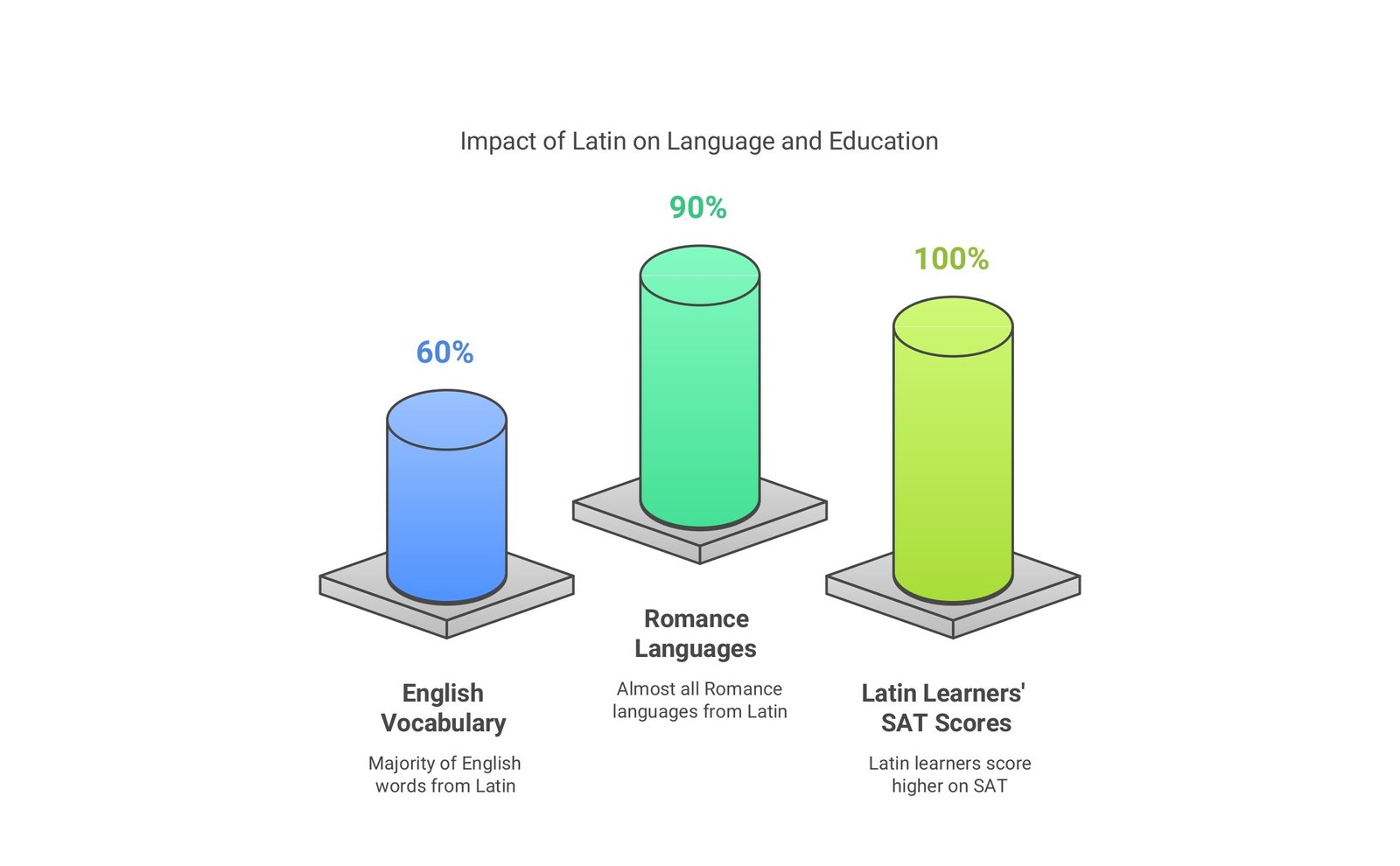How to make language learning easier is a question I hear all the time—from students overwhelmed by grammar to teachers looking for better ways to help their classes connect the dots. Learning a new language can feel like a puzzle with missing pieces.
That’s why this topic matters. Many struggle because they never build a strong foundation—and that’s where Latin comes in. It’s not just an old, “dead” language. It’s the root of many modern ones, and it can unlock faster, deeper understanding.
In this article, I’ll show you how Latin works as a powerful tool to improve grammar, boost vocabulary, and support learning other languages—especially for beginners. As the founder of LatinPerDiem, I’ve seen firsthand how Latin opens doors. Let’s explore how it can help you or your students build confidence and clarity in any language journey.
Key Takeaways
- Latin gives you a head start when learning Romance languages like Spanish, French, and Italian.
- Over 60% of English words come from Latin, making it easier to build vocabulary fast.
- Studying Latin improves grammar skills by teaching clear sentence structure and rules.
- Latin builds pattern recognition, helping you spot word roots and meanings in other languages.
- A few Latin words go a long way—start small and you’ll see fast progress.
- Common myths about Latin (like it being “useless” or “too hard”) are easily debunked.
How Does Latin Help in Learning Other Languages?
Latin helps in learning other languages by teaching grammar rules, boosting vocabulary, and building word recognition. Since many English and Romance language words come from Latin, you can spot patterns and understand new words more easily. This makes learning French, Spanish, or Italian faster and clearer.
Facts & Findings: How Latin Improves Language Learning
Latin isn’t just ancient—it’s a powerful tool for modern learners. Below are key insights that show why Latin still matters in today’s classrooms and study routines.
Compelling Data & Stats
| Fact | Insight |
| Over 60% of English words come from Latin. | Learning Latin improves your ability to decode English vocabulary. (Oxford English Dictionary) |
| 90% of Romance language vocabulary is Latin-based. | Knowing Latin helps learners transition easily into Spanish, French, and Italian. (Ethnologue Language Family Tree) |
| Students who study Latin score 150+ points higher on verbal SAT sections. | Latin improves reading comprehension and grammar understanding. (National Committee for Latin and Greek) |
| 1 in 4 U.S. high schools offers Latin as an elective. | Indicates growing academic support and recognition. (American Classical League, 2022 Survey) |
What Is the Role of Latin in Learning Other Languages?
Latin is more than an ancient language—it’s a powerful learning tool. When you study Latin, you’re training your brain to recognize patterns, decode grammar, and build vocabulary that transfers across languages.
Think of Latin as the root system beneath a tree. You may not see it, but it supports and feeds everything above. That’s how Latin works in language learning. It forms the base of Romance languages like Spanish, French, and Italian. It also shapes over half of English vocabulary.
Because Latin is highly structured, it teaches you how language works at a deeper level. This helps learners spot grammar rules, understand sentence structure, and make sense of new words faster.
In short, the importance of Latin in linguistics lies in how it strengthens your foundation—no matter what language you’re trying to learn next.
Why Latin Still Shapes Today’s Linguistics
Latin’s Historical Significance
For centuries, Latin was the global language of education, science, and law. From Roman times through the Middle Ages, scholars, doctors, and theologians wrote and studied in Latin. Universities across Europe taught in Latin well into the 19th century. This gave Latin a deep, lasting influence on academic vocabulary and thought. Even today, many legal and medical terms still come straight from Latin, like habeas corpus or in vitro. Latin isn’t just history—it’s the language that carried knowledge through the ages.
Latin Roots in Romance Languages
Latin is the mother of Romance languages like Spanish, French, Italian, Portuguese, and Romanian. These languages grew directly from spoken Latin. That’s why many words look and sound so familiar. For example, the Spanish word amar (to love) comes from Latin amare. French eau (water) comes from Latin aqua. This shared root system makes it easier to learn these languages once you understand some basic Latin. Learning Latin gives you a shortcut to unlocking vocabulary and grammar in multiple modern tongues.
Latin’s Impact on English Vocabulary
Even though English isn’t a Romance language, more than 60% of its vocabulary has Latin roots. Words like manual (from manus, meaning hand) or audible (from audire, to hear) come from Latin. In fact, Latin-origin, polysyllabic words often sound more formal—like elevate vs. the Germanic lift. By studying Latin, learners start to recognize how English is built. This boosts reading comprehension and makes it easier to guess the meaning of unfamiliar words. Latin improves vocabulary in both obvious and surprising ways.
Benefits of Studying Latin for Language Learners
Improves Grammar Understanding
Latin is a highly structured language. Every sentence follows clear rules for word order, tense, and agreement. Learning Latin trains your brain to think in patterns. You start to notice how nouns, verbs, and cases work together—skills that transfer directly to other languages. If you’re tackling Spanish verbs or German cases, the grammar feels less scary. Latin also builds mental discipline, helping students become better writers and readers in their native language. It’s like a grammar workout for your brain.
Improves Vocabulary Acquisition
One major reason how Latin improves vocabulary is its use of root words that appear across English and Romance languages. For example, the Latin root portare (to carry) shows up in words like transport, export, and portable. By studying just a few Latin roots, you can decode the meaning of many unfamiliar words. This is especially helpful for standardized tests like the SAT, ACT, or GRE. Latin doesn’t just teach words—it teaches word-building.
Builds a Strong Foundation for Learning Other Languages
If you’re serious about learning French, Spanish, or Italian, Latin is the best place to start. Learning languages through Latin gives you early access to shared roots, sentence structures, and even pronunciation patterns. You’ll pick up vocabulary faster and understand grammar more easily. Even your English will improve!
Most of All, Enables You to Read Classical Authors in their Own Words
Why read the ancient greats through a translation, when you can access them directly. No more kissing through a window pane, so to speak.
Step-by-Step: How to Learn Other Languages Through Latin
Want to use Latin as a springboard to learn French, Spanish, or even improve your English? Here’s a simple process to get started:
- Learn 10–15 core Latin root words.
Start with basics like aqua (water), videre (to see), and scribere (to write).
👉 Once you know “videre,” you’ll spot it in words like “video,” “visual,” and “evidence.” - Practice Latin grammar rules.
Understanding cases and verb endings will help you recognize patterns in other languages. - Compare Latin words with modern equivalents.
Try pairing amare (to love) with amour (French) or amor (Spanish).
Common Myths and Mistakes About Latin Learning
“Latin is a dead language.”
Not true. While Latin isn’t spoken conversationally as much as other languages, it’s very much alive in over 60% of English vocabulary and nearly all Romance languages. As Professor Eleanor Dickey notes, “Studying Latin can give learners a powerful understanding of how modern languages work.” And, there are more than 3000 active Latin practitioners worldwide. Join a unique community.
“You have to be a scholar to study Latin.”
Nope! Anyone can start learning Latin today via LatinPerDiem. You don’t need a classical education—just curiosity.
“Latin won’t help with modern languages.”
Quite the opposite. Latin improves grammar awareness, builds vocabulary, and speeds up learning French, Spanish, Italian, and even English.
Mistake to avoid:
Don’t try to memorize everything at once. Focus on root words and basic grammar first—it’s the foundation for lasting progress.
“It’s true Latin isn’t spoken on the streets as much as the vernaculars—but that doesn’t make it dead. It’s very much alive in the languages we speak daily, and there are around 3000 active speakers around the world. Why not join their ranks?”
Real-World Examples – Latin as a Language Learning Superpower
Students and teachers alike often say the same thing: Latin unlocks language learning in a way no modern class ever did. One high school student shared, “I learned more about Spanish grammar from Latin than I did in Spanish class.” That moment stuck with me—and I’ve heard it many times since.
Teachers report that students who study Latin first grasp new vocabulary and grammar faster when learning Spanish, French, or Italian. It’s not just academic—it’s practical.
Even adult learners using LatinPerDiem’s daily lessons say they feel more confident spotting root words in business English or foreign phrases while traveling.
If you’re preparing for college, brushing up your skills, or starting fresh, Latin builds a bridge to fluency.
Conclusion
Latin isn’t just a subject from the past—it’s a smart step forward in today’s language learning. By understanding Latin, students and teachers gain a strong base in grammar, a richer vocabulary, and an easier path to learning languages like Spanish, French, or even English. It trains the mind to think clearly, spot patterns, and make connections across languages. Whether you’re new to teaching, a curious student, or simply want better results, Latin can be your key to success. At LatinPerDiem, we believe language should empower—not confuse. So take that first step, explore the roots, and discover how Latin can transform the way you learn and teach.
Frequently Asked Questions (FAQ)
Is Latin still useful for learning new languages today?
Yes, Latin is still very useful. It builds a strong base for learning Romance languages like Spanish, French, and Italian. It also improves English grammar and vocabulary skills. Latin helps you see language patterns more clearly.
Do I need to become fluent in Latin to benefit from it?
No, fluency isn’t the goal. Even learning just a few key Latin roots can help you understand words in many other languages. Think of Latin as a language learning tool, not a language you have to master.
How does Latin help with vocabulary building?
Latin improves vocabulary by showing you the root meanings behind words. For example, once you know “aqua” means water, you’ll recognize it in words like aquarium or aquatic in English—and agua in Spanish.
Is Latin only useful for European languages?
While Latin mainly supports European languages, especially Romance ones, it also improves how you learn any structured language. It trains your brain to recognize grammar rules and word roots—even in English, which is 60% Latin-based.
Can I learn Latin online for free, even outside the U.S.?
Yes! You can study Latin from anywhere using LatinPerDiem Website, or YouTube. Many global learners start with just 10 root words and quickly see results in language learning.



